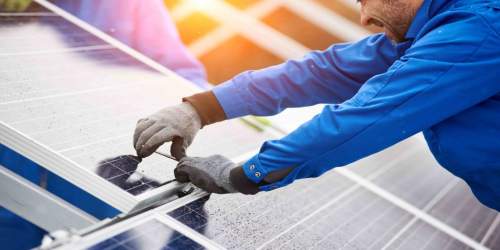Read Time : 2 Minutes
How do Solar Cells make Electricity
What is Solar Energy?
Solar cell energy is the conversion of sunlight into usable energy for your home or business. The process is quite simple, and is involves solar cells absorbing the sun’s rays before using them to produce a voltage in order to generate electric power. The solar cells themselves are made from a material that permits the absorbed light to raise an electron to a higher energy state and transport this electron from the solar cell into an external circuit. After this, the electron disperses its energy and returns to the solar cell in order to restart the cycle. The vast majority of solar cells that are produced are composed of a silicon semiconductor material. Silicon is the second most abundant element found on the Earth, which is an advantage that has benefitted its processing in the solar energy field. In addition to this, it does not cause any burden or further damage to the environment. The production process of solar cells refers to the introduction of chemicals into the silicon semiconductor, which then leads to the obtainment of a surplus of either positive or negative charge carriers from the semiconductor material. If the two layers are combined, it results in a “p-n-junction”, where an interior, electric field is built up. This then leads to the separation of charge carriers which were initially released by sunlight. As a result of this, an electric charge is produced. You can find out more about solar energy here on our main page.
COMPARE PRICES FROM LOCAL INSTALLERS
Compare prices from local companies fast & free
Enter your postcode to compare quotes from leading professionals. We promise to keep your information Safe & Secure. Privacy Policy
How Does Solar Energy Work?
First, the sunlight is gathered by the solar cells. Following this, the current leaves the module (or the array of modules), and passes through a wire conduit that leads to an inverter. This turns the direct current (DC) into an alternating current (AC). The AC is the current that all appliances and household items run on. Following on from the inverter, the current that has been generated from solar energy feeds into the circuit of the household or business in question as well as onto the electrical grid of the region. It is also possible to have a self-contained circuit that is independent of the grid. Solar energy cells save people thousands of pounds in electricity bills each year. Although, this does depend on the size of the solar system you have installed. In recent years, the cost of solar panels has been on the decline – which is great for those looking to invest. It has become far more affordable for houses and businesses. Alongside the decline in price, you also have the rise of popularity of solar panels. The increase in demand has means that the industry has scaled up manufacturing and improved the technology with new and more efficient materials. Installation costs have also declined as more experienced installers come to light.
Types of Solar Cells
There are three different types of solar cell available: monocrystalline, polycrystalline and thin film cells. You can learn more about the different types here. In order to create a monocrystalline solar cell, you need to have a semiconductor material. This form of solar cell is formed by melting silicon before being sliced into thin plates. This guarantees a higher level of efficiency from the cells. The polycrystalline cells have the advantage of being far more efficient in terms of cost. They are manufactured by pouring silicon into blocks before they are sliced into plates. As the material begins the process of solidification, crystal structures are formed. While they are cheaper to manufacture, the polycrystalline cells are, unfortunately, less efficient than the monocrystalline cells. A thin film cell is when a silicon film is placed on a substrate material like glass. As a result of the thinness of the layer, the cost of materials is low and so is the production cost. However, one disadvantage of the thin film cell is its efficiency levels. These are much lower than the other two forms of solar cell. As a result, thin film cells are primarily used in small electronic devices, such as calculators, where the energy requirements are minimal.
Get Quotes on Solar Cells
It's not always easy to decide what kind of solar cells you want, and so if you have made the decision to invest we are here and ready to help. All you need to do is fill out the no obligation form on this page with some of your preferences and information. Following that, our experienced and professional installers will contact you with information regarding solar cells. They will also supply you with a range of offers that you are free to choose from. The service itself is free and only takes a few minutes to complete.
Find a local installer
Welcome to the biggest directory of UK renewable energy companies





 How Much do Solar Panel Systems Cost in 2024?
How Much do Solar Panel Systems Cost in 2024?







